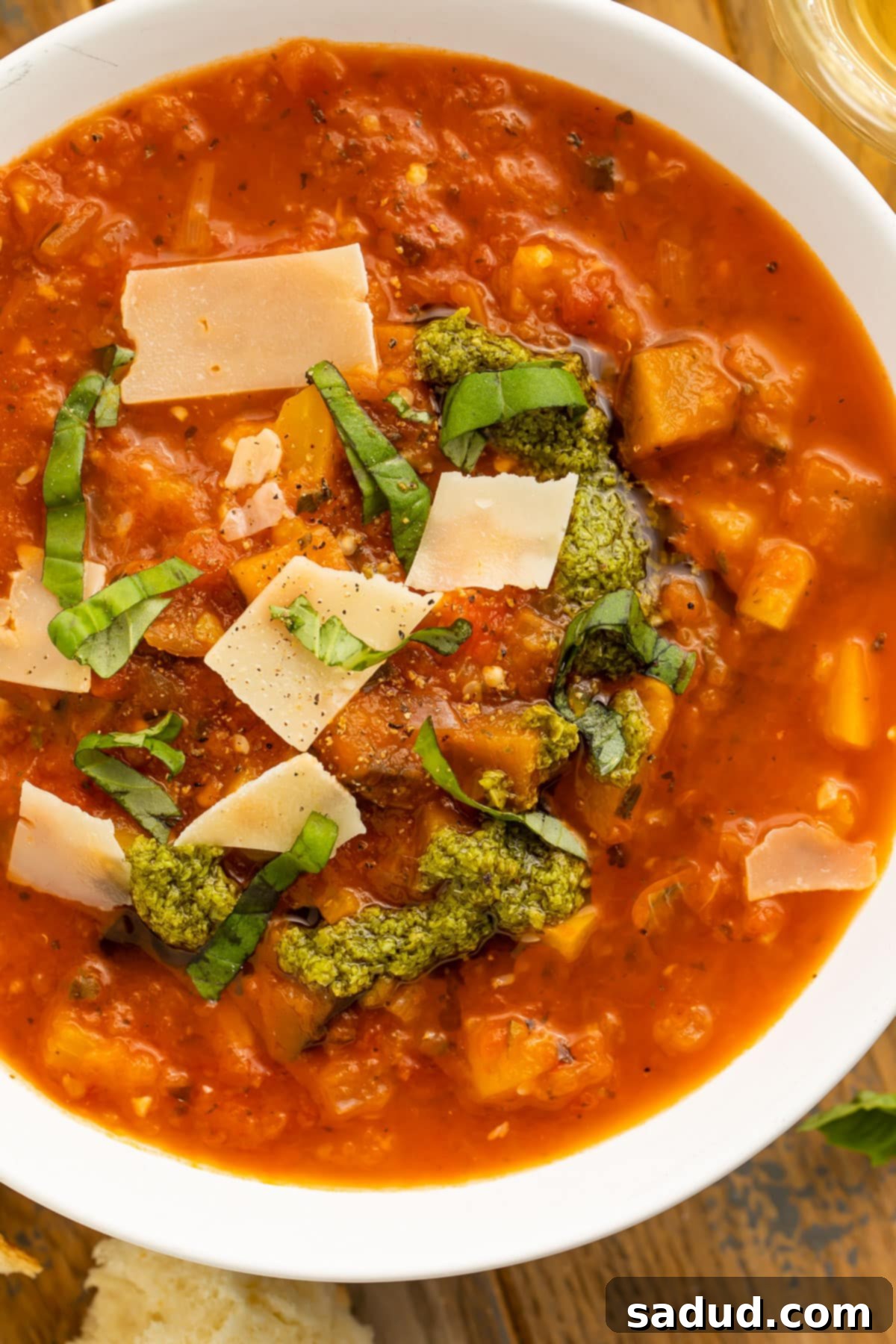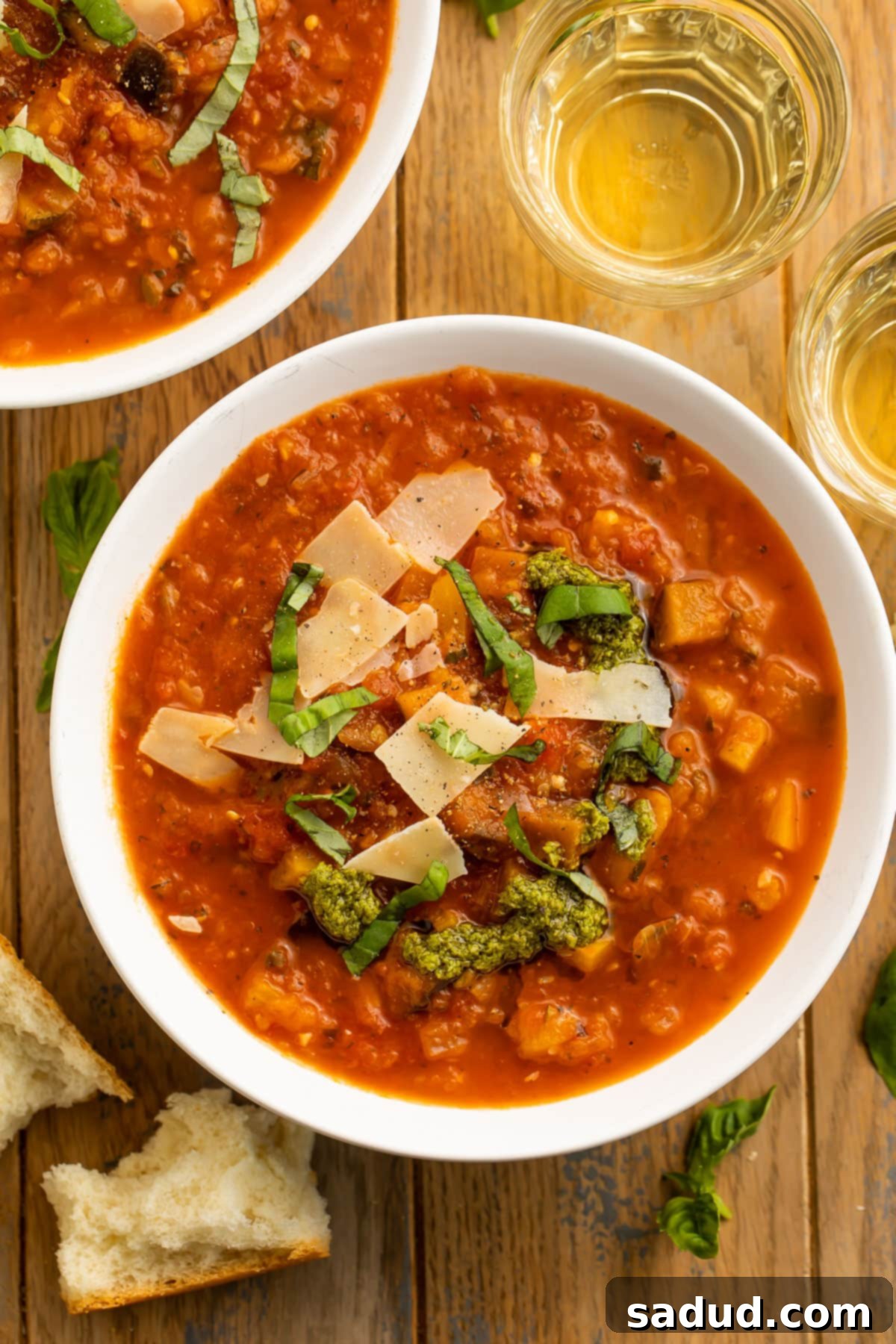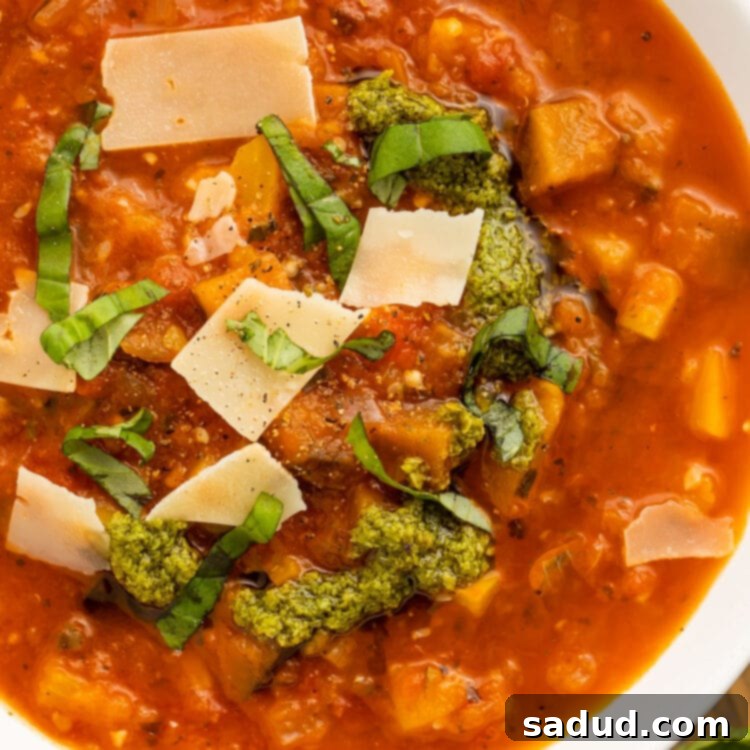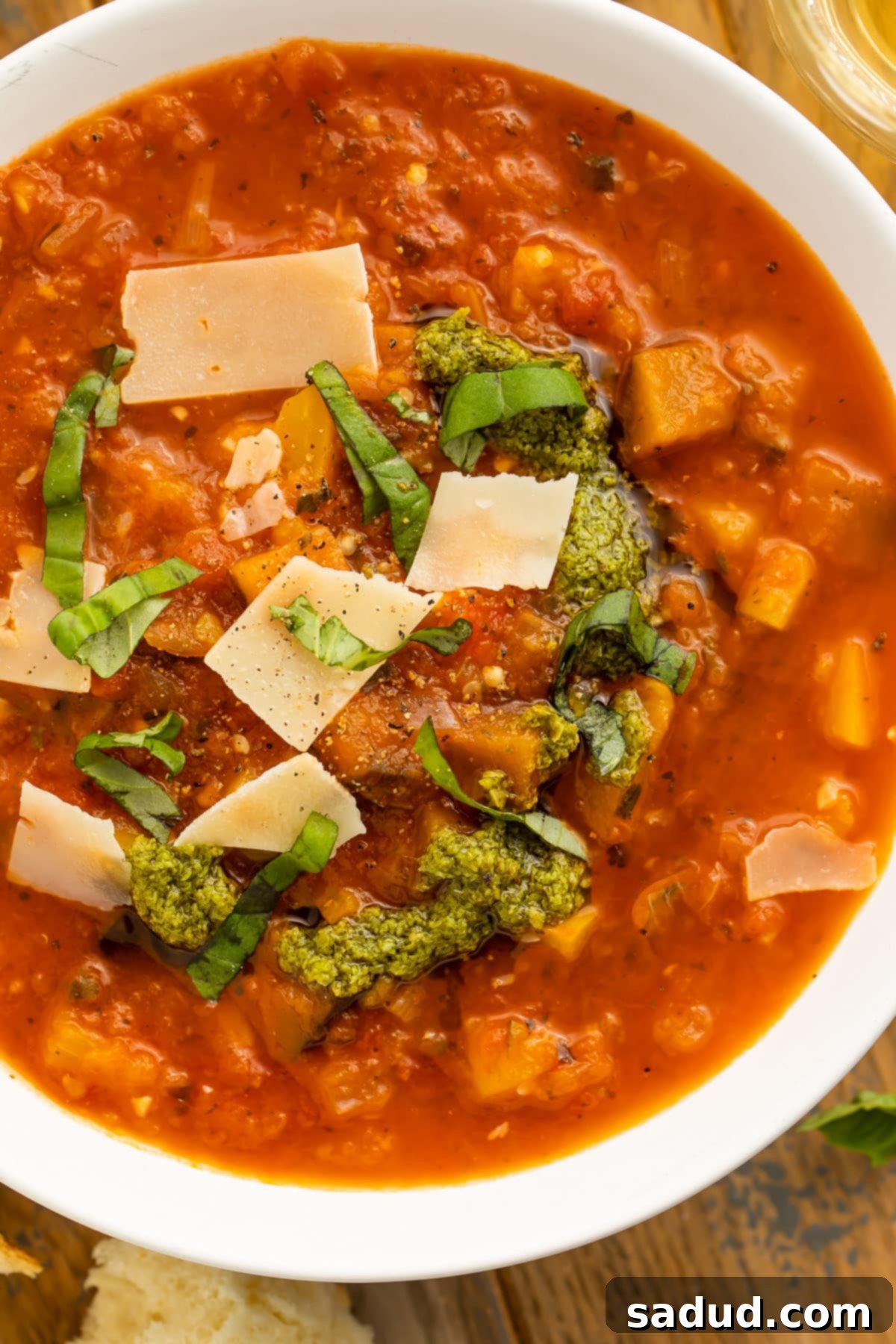Hearty & Healthy Ratatouille Soup: An Easy French Vegetable Delight
Discover a vibrant and incredibly flavorful twist on the classic French Provençal dish with this hearty ratatouille soup. Bursting with the fresh tastes of summer vegetables like tender eggplant, crisp zucchini, sweet bell peppers, and sun-ripened tomatoes, this recipe transforms the traditional stew into a comforting and nutritious soup. It’s a culinary journey to the south of France, made simple and quick for any day of the week. Serve this delightful soup adorned with rich Parmesan shavings, a swirl of herbaceous pesto, and alongside warm, crusty French baguettes for the ultimate meatless meal that satisfies both the soul and the palate.

What Makes This Ratatouille Soup Recipe So Good?
- A Comforting Spin on a French Classic: Ratatouille is a beloved French stew originating from the beautiful region of Provence, known for its bounty of fresh produce. Traditionally, it features a medley of garden vegetables like eggplant, zucchini, bell pepper, and tomatoes, often stewed and artfully arranged. We’ve taken this timeless recipe and elevated it to a new level by transforming it into a luxuriously comforting and deeply flavorful soup. This innovative approach offers all the delightful tastes of authentic ratatouille but in a smooth, warm, and wonderfully satisfying liquid form, perfect for dipping or sipping.
- Effortless, Nutritious, and Diet-Friendly: This ratatouille soup isn’t just delicious; it’s an incredibly easy, low-calorie dish that perfectly fits into a busy lifestyle. Requiring only about 30 minutes of active cooking time, it’s an ideal choice for quick weeknight dinners when you crave something wholesome without the fuss. Beyond its convenience, this soup is a powerhouse of nutrition. It’s naturally vegetarian, making it suitable for plant-based diets, and is also low-carb and gluten-free, accommodating a wide range of dietary needs and preferences. Even those notoriously picky eaters in your family will be won over by the comforting warmth and subtle sweetness of this vegetable-rich soup. It’s a fantastic way to sneak in extra veggies!
- Incredibly Versatile for Any Meal: One of the greatest attributes of this ratatouille soup is its remarkable versatility. Packed with delicious and nutrient-dense vegetables, it’s hearty enough to be enjoyed entirely on its own as a light yet fulfilling lunch or dinner. However, its balanced flavor profile also makes it an excellent accompaniment. Pair it with a gourmet grilled cheese sandwich for a comforting duo, serve it as an elegant starter before your main course, or enjoy it as a nutritious side dish. If you’re wondering what main course would complement it best, consider savory pork chops, a perfectly cooked flank steak, or even grilled chicken or a hearty plant-based protein like lentils or chickpeas. The possibilities are truly endless, making this soup a staple in your culinary repertoire.
Chef’s Expert Tips for the Best Ratatouille Soup
- Mastering the Art of Chiffonading Basil: While entirely optional, chiffonading your basil leaves is a simple technique that truly elevates the visual appeal and aromatic profile of your soup. The process is surprisingly easy: simply stack several fresh basil leaves on top of one another, gently roll them lengthwise into a tight cylinder, and then thinly slice them horizontally to create elegant, delicate ribbons. These basil ribbons not only add a burst of fresh, herbaceous flavor but also introduce a professional, restaurant-quality touch to your presentation. If you’re short on time, a quick chop will suffice, but for that extra special touch, chiffonading is worth the minimal effort.
- Effortless Meal Prep for Busy Weeks: This ratatouille soup is an absolute dream for meal prepping! Preparing a larger batch means you’ll have delicious, healthy meals ready to go throughout the week, saving you time and ensuring you stick to your nutritious eating goals. When stored properly in an airtight container, this soup will maintain its fresh flavors and nutritional quality in the refrigerator for up to 4 days. For longer-term planning, it freezes beautifully for up to 3 months, making it perfect for those moments when you need a quick, wholesome meal without any cooking involved. Simply thaw, reheat, and enjoy!
- Selecting the Freshest Ingredients: The key to an outstanding ratatouille soup lies in the quality of your produce. Always opt for fresh, seasonal vegetables when possible. Look for eggplants that are firm and shiny, zucchini that are smooth and unblemished, and bell peppers that are vibrant in color and firm to the touch. Ripe, juicy tomatoes will provide the best base flavor. Using high-quality ingredients ensures a richer, more authentic taste in your soup.
- Layering Flavors Through Sautéing: Don’t rush the initial sautéing of your aromatics. Heating the avocado or olive oil until shimmery and then gently softening the onions and garlic allows their sweet and pungent flavors to fully develop and infuse the oil. This foundational step is crucial for building a deep, complex flavor base for your entire soup. Sautéing the bell peppers, zucchini, and eggplant until they just begin to soften also helps release their natural sugars and flavors, contributing to the overall deliciousness of the dish.
- Adjusting Consistency to Your Liking: The beauty of this soup is that you can tailor its texture to your preference. If you enjoy a heartier, thicker soup, you can blend a smaller portion or blend it less thoroughly, leaving some chunks of vegetables. For a super smooth and creamy consistency, blend a larger portion or blend until perfectly velvety. If the soup is too thick after blending, you can easily thin it out by adding a splash more vegetable stock or water until it reaches your desired consistency. Remember to taste and adjust seasonings after any additions.
Beyond the Basics: Customizing Your Ratatouille Soup
While this recipe provides a fantastic foundation for a classic ratatouille soup, don’t hesitate to get creative and customize it to your personal taste. Here are a few ideas to inspire you:
- Add a Protein Boost: For an even more filling meal, consider adding a source of protein. Canned chickpeas or white beans can be stirred in during the last 10 minutes of simmering for a plant-based addition. Cooked chicken breast, crumbled Italian sausage (plant-based or regular), or even a few poached eggs can also be wonderful additions to individual servings.
- Spice It Up: If you enjoy a bit of heat, a pinch of red pepper flakes added with the dried herbs can give your soup a delightful kick. Smoked paprika can also add a subtle depth and smoky flavor.
- Fresh Herb Medley: While basil and parsley are traditional, feel free to experiment with other fresh herbs. A sprig of fresh thyme or a bay leaf added during simmering can infuse the soup with additional aromatic notes. A squeeze of fresh lemon juice at the end can brighten all the flavors.
- Cheesy Swirl: Beyond Parmesan, a dollop of creamy goat cheese or a swirl of ricotta can add a rich, tangy counterpoint to the vegetables.
- Serve with Grains: For a more substantial bowl, serve the soup over a small scoop of cooked quinoa, brown rice, or a spoonful of small pasta like ditalini or orzo.
A Taste of Provence: The Rich History of Ratatouille
The humble origins of ratatouille trace back to the city of Nice in the Provence region of southeastern France, specifically in the late 18th century. Initially, it was a simple, rustic dish prepared by poor farmers and peasants using fresh, abundant vegetables harvested from their summer gardens. The word “ratatouille” itself comes from the Occitan word “ratatolha” and the French “touiller,” meaning to toss or stir, aptly describing the method of cooking the vegetables together. Over time, this peasant dish evolved, gaining sophistication and eventually becoming a beloved staple of French cuisine, celebrated worldwide for its vibrant colors, fresh flavors, and healthy ingredients. Our soup rendition pays homage to this rich history, offering a modern, accessible way to enjoy the classic tastes of Provence.

Don’t Miss These Can’t-Miss Soup Recipes
- Cream Of Onion Soup
- Hazelnut Soup with Parsnips
- Tomato Florentine Soup
- Mexican Chili
- Instant Pot Potato Leek Soup
- Boilermaker Chili
- Creamy Corn Soup
- Wonton Egg Drop Soup
- Chickarina Soup
- Potato Asparagus Soup
If you loved this recipe as much as we did, don’t forget to leave us a review below. ★ Follow Easy Healthy Recipes on Pinterest, Facebook, and Instagram, too!
For more delicious recipes, visit our sister sites, 40 Aprons and Easy Cheap Recipes.

Ratatouille Soup
 Cheryl Malik
Cheryl Malik
Print
SaveSaved!
Ingredients
For the Ratatouille Soup
- 1 tablespoon avocado oil or olive oil, for sautéing
- 1 medium onion chopped; approximately 1 cup, for flavor base
- 2-3 cloves garlic minced, to enhance aroma
- 2 cups chopped bell pepper approximately 1 large bell pepper, yellow or orange for sweetness and color; core removed, seeds removed
- 2 cups chopped zucchini approximately 2 small zucchinis or 1 large zucchini, adds tenderness
- 2 cups chopped eggplant approximately 1 small eggplant or half of 1 large eggplant, for a meaty texture
- 1 28-ounce can tomatoes whole or crushed, San Marzano preferred for best flavor; undrained
- 1 28-ounce carton vegetable stock
- 1 teaspoon salt more or less to taste, enhances all flavors
- 2 teaspoons dried basil or 2 tablespoons finely chopped fresh basil, for that classic Mediterranean taste
- 1 teaspoon dried parsley or 1 tablespoon finely chopped fresh parsley
- freshly cracked black pepper to taste, for a subtle kick
Serving Suggestions (All Optional)
- pesto for an extra herbaceous touch
- 2 tablespoons chiffonaded basil leaves for garnish and fresh aroma
- shaved fresh parmesan for a rich, salty topping
- baguettes for dipping
Equipment
-
large soup pot or dutch oven, for even cooking
-
large wooden spoon for stirring
-
ladle for serving and transferring soup
-
traditional blender or immersion blender, see Notes for blending options
-
Large bowl if using immersion blender, see Notes
Instructions
-
Add 1 tablespoon avocado oil (or olive oil) to a large soup pot or Dutch oven. Heat the pot on your stovetop over medium-high heat. Swirl or tilt the pot occasionally to ensure the oil is evenly distributed across the entire surface and heat it until the oil is hot and appears shimmery. This ensures your aromatics will sauté beautifully.
-
Once the oil is ready and hot, add the 1 medium onion (chopped) and 2-3 cloves of minced garlic to the pot. Stir well to incorporate them with the oil, then sauté for about 3 minutes, or until the onions have become translucent and softened and the garlic is fragrant, taking care not to burn it. This step builds the foundational flavor of your soup.
-
Next, add the prepared vegetables: 2 cups chopped bell pepper, 2 cups chopped zucchini, and 2 cups chopped eggplant. Stir all the vegetables thoroughly to ensure they are well coated with the oil and aromatics. Cook for approximately 5 minutes, stirring occasionally, allowing the vegetables to begin softening and release their natural flavors.
-
After the vegetables have cooked for 5 minutes, it’s time to add the liquid and seasonings. Carefully pour in 1 28-ounce can of tomatoes (whole or crushed), 1 28-ounce carton of vegetable stock, 1 teaspoon salt, 2 teaspoons dried basil, and 1 teaspoon dried parsley. Stir gently to fully incorporate all ingredients and bring the entire mixture to a rolling boil.
-
Once the soup mixture is boiling, immediately reduce the heat under the pot to medium-low. Allow the soup to simmer uncovered for 20 minutes, or until all the vegetables have become wonderfully tender and the flavors have melded together beautifully. Keep an eye on the liquid level and stir occasionally.
-
When the vegetables have softened to your liking, carefully ladle approximately 50% of the soup into a traditional blender. Set the blender aside and allow the soup to cool for 3 to 5 minutes – this is crucial for safe blending of hot liquids. Then, with caution, blend the mixture until it is completely smooth and creamy. Please refer to the “Notes for Blending Hot Liquids” section below for essential safety tips to prevent accidents.
-
Return the blended, smooth portion of the soup back to the pot with the remaining chunky soup. Stir thoroughly to reincorporate and create a consistent texture. Now is the time to taste the soup and adjust the seasonings as needed. Add additional salt and/or freshly cracked black pepper if desired, until it perfectly suits your palate.
-
Ladle the freshly prepared, hot ratatouille soup into individual serving bowls. For an exquisite finish, top each serving with pesto to taste, approximately ½ tablespoon of elegant chiffonaded basil leaves, and a generous sprinkle of shaved fresh Parmesan, if you desire. Serve immediately with warm pieces of crusty baguettes for dipping. Enjoy this comforting taste of France!
Notes
- Immersion Blender Method: If you prefer using an immersion blender for its convenience and less mess, you can do so directly in the soup pot. First, ladle about 50% of the soup into a separate large bowl and set it aside. This prevents over-blending and allows for a smoother consistency. Remove the soup pot from the heat and let the soup cool slightly for a few minutes. Then, insert the immersion blender directly into the pot and blend the soup until it reaches your desired level of smoothness. Once blended, return the reserved, unblended soup from the large bowl back into the pot and stir well to reincorporate everything, ensuring a uniform texture.
- How to Chiffonade Basil: To create beautiful, delicate basil ribbons, start by stacking several fresh basil leaves neatly on top of each other. Gently roll the entire stack lengthwise into a tight, cigar-like cylinder. Then, using a sharp knife, slice perpendicular to the basil roll, creating long, thin, elegant ribbons of basil. This technique not only looks professional but also helps release the basil’s aromatic oils, enhancing the flavor and scent of your dish.
Essential Tips for Safely Blending Hot Liquids
Blending hot liquids can be hazardous if not done correctly, as steam can build up and cause the lid to blow off. Follow these safety tips:
- Don’t Overfill: Always fill your blender pitcher no more than halfway with hot liquid. If you have a large batch of soup, work in small batches as needed. This prevents excessive steam buildup and ensures proper blending.
- Allow to Cool Slightly: Before blending, let the soup cool down for at least 3 to 5 minutes after removing it from the heat. This reduces the initial high temperature and minimizes steam pressure inside the blender.
- Vent the Lid: Crucially, remove the center cap or stopper from your blender lid. This opening allows steam to escape safely. To prevent splatters, cover the open lid with a clean kitchen dish towel.
- Secure and Start Slowly: While holding the blender lid down firmly with the dish towel (to keep steam and splashes contained), start blending on the lowest speed setting. Blend in short bursts, gradually increasing speed if necessary, until your desired consistency is achieved. This controlled approach helps manage pressure and ensures safety.
Nutrition Information
Number of total servings shown is approximate. Actual number of servings will depend on your preferred portion sizes.
Nutritional values shown are general guidelines and reflect information for 1 serving using the ingredients listed, not including any optional ingredients. Actual macros may vary slightly depending on specific brands and types of ingredients used.
To determine the weight of one serving, prepare the recipe as instructed. Weigh the finished recipe, then divide the weight of the finished recipe (not including the weight of the container the food is in) by the desired number of servings. Result will be the weight of one serving.
